VOLVO V60 2014 Owners Manual
Manufacturer: VOLVO, Model Year: 2014, Model line: V60, Model: VOLVO V60 2014Pages: 442, PDF Size: 13.85 MB
Page 201 of 442
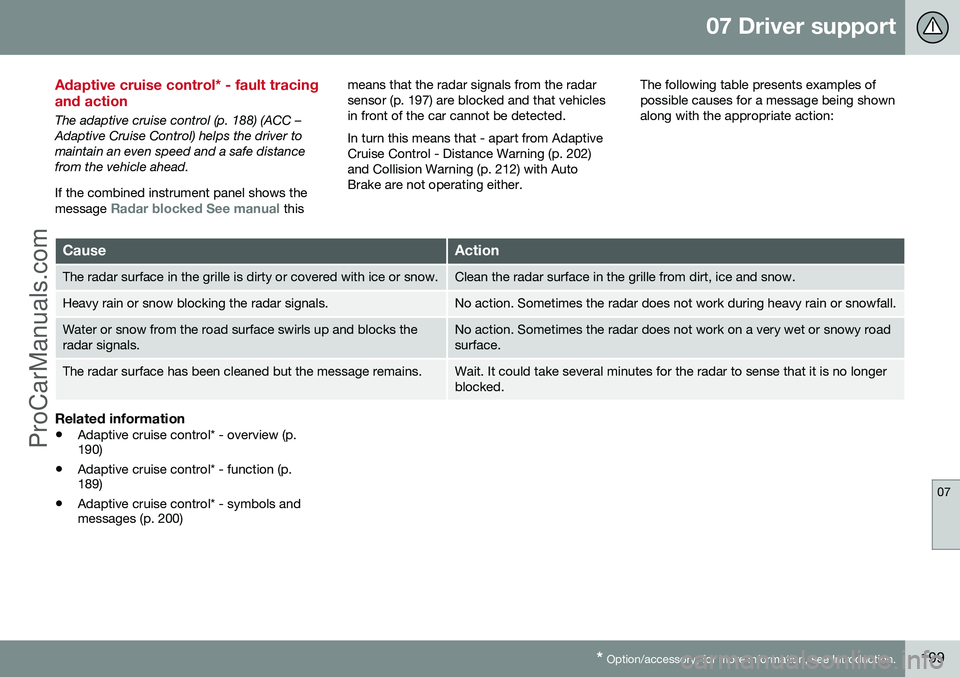
07 Driver support
07
* Option/accessory, for more information, see Introduction.199
Adaptive cruise control* - fault tracing and action
The adaptive cruise control (p. 188) (ACC – Adaptive Cruise Control) helps the driver tomaintain an even speed and a safe distancefrom the vehicle ahead. If the combined instrument panel shows the message
Radar blocked See manual this means that the radar signals from the radar sensor (p. 197) are blocked and that vehiclesin front of the car cannot be detected. In turn this means that - apart from Adaptive Cruise Control - Distance Warning (p. 202)and Collision Warning (p. 212) with AutoBrake are not operating either.
The following table presents examples ofpossible causes for a message being shownalong with the appropriate action:
CauseAction
The radar surface in the grille is dirty or covered with ice or snow.Clean the radar surface in the grille from dirt, ice and snow.
Heavy rain or snow blocking the radar signals.No action. Sometimes the radar does not work during heavy rain or snowfall.
Water or snow from the road surface swirls up and blocks the radar signals.No action. Sometimes the radar does not work on a very wet or snowy road surface.
The radar surface has been cleaned but the message remains.Wait. It could take several minutes for the radar to sense that it is no longer blocked.
Related information
•
Adaptive cruise control* - overview (p. 190)
• Adaptive cruise control* - function (p.189)
• Adaptive cruise control* - symbols andmessages (p. 200)
ProCarManuals.co’
Page 202 of 442
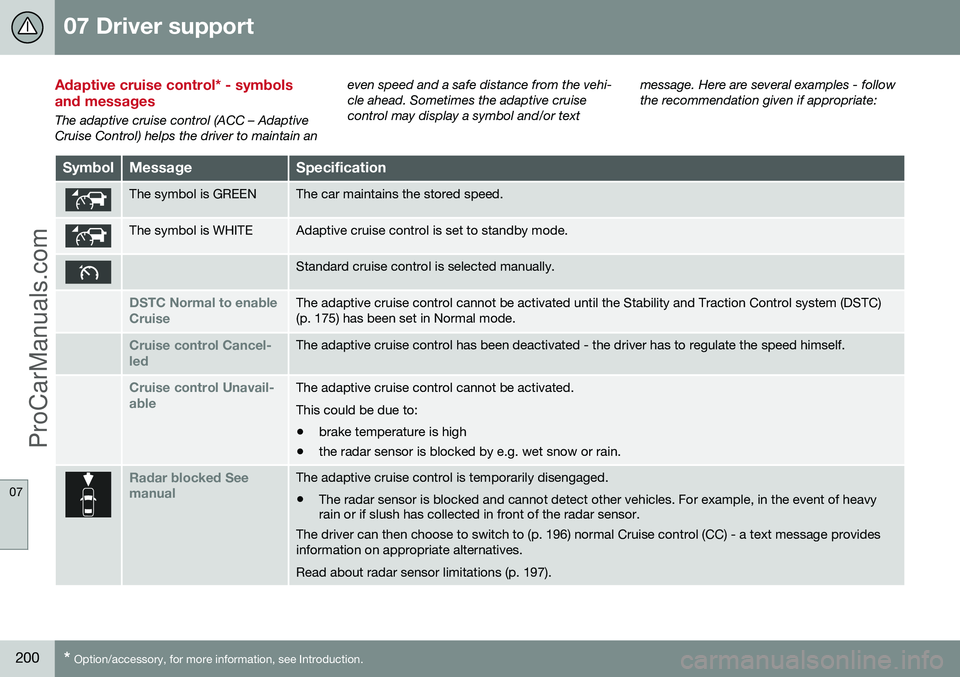
07 Driver support
07
200* Option/accessory, for more information, see Introduction.
Adaptive cruise control* - symbols and messages
The adaptive cruise control (ACC – Adaptive Cruise Control) helps the driver to maintain an even speed and a safe distance from the vehi-cle ahead. Sometimes the adaptive cruisecontrol may display a symbol and/or text
message. Here are several examples - followthe recommendation given if appropriate:
SymbolMessageSpecification
The symbol is GREENThe car maintains the stored speed.
The symbol is WHITEAdaptive cruise control is set to standby mode.
Standard cruise control is selected manually.
DSTC Normal to enable CruiseThe adaptive cruise control cannot be activated until the Stability and Traction Control system (DSTC) (p. 175) has been set in Normal mode.
Cruise control Cancel- ledThe adaptive cruise control has been deactivated - the driver has to regulate the speed himself.
Cruise control Unavail- ableThe adaptive cruise control cannot be activated. This could be due to:
• brake temperature is high
• the radar sensor is blocked by e.g. wet snow or rain.
Radar blocked See manualThe adaptive cruise control is temporarily disengaged.
• The radar sensor is blocked and cannot detect other vehicles. For example, in the event of heavy rain or if slush has collected in front of the radar sensor.
The driver can then choose to switch to (p. 196) normal Cruise control (CC) - a text message provides information on appropriate alternatives. Read about radar sensor limitations (p. 197).
ProCarManuals.co’
Page 203 of 442
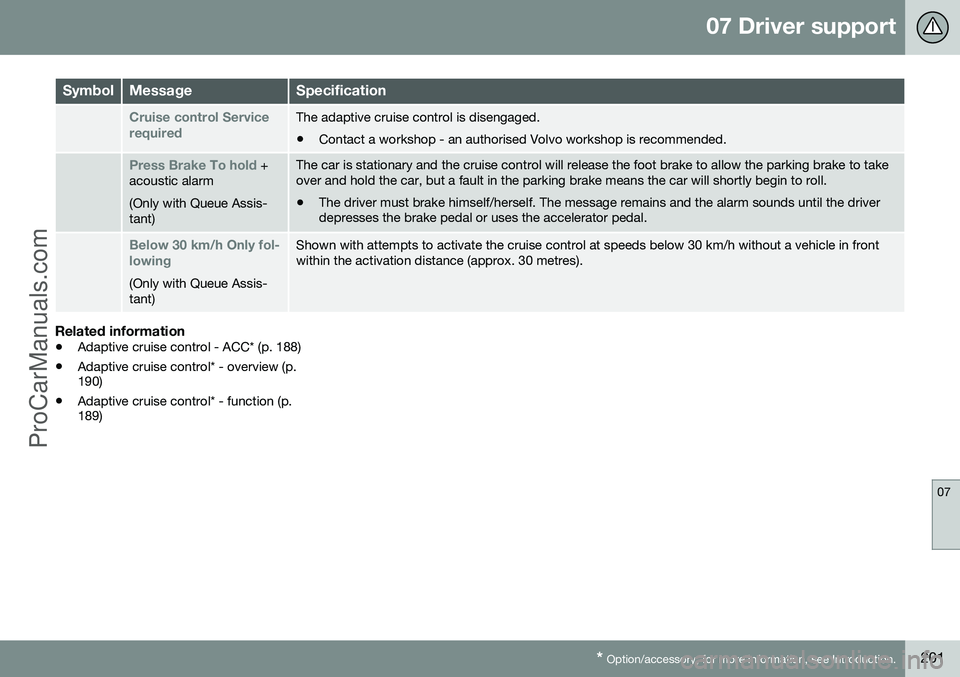
07 Driver support
07
* Option/accessory, for more information, see Introduction.201
SymbolMessageSpecification
Cruise control Service requiredThe adaptive cruise control is disengaged. • Contact a workshop - an authorised Volvo workshop is recommended.
Press Brake To hold +
acoustic alarm (Only with Queue Assis- tant)The car is stationary and the cruise control will release the foot brake to allow the parking brake to take over and hold the car, but a fault in the parking brake means the car will shortly begin to roll.
• The driver must brake himself/herself. The message remains and the alarm sounds until the driver depresses the brake pedal or uses the accelerator pedal.
Below 30 km/h Only fol- lowing
(Only with Queue Assis- tant)
Shown with attempts to activate the cruise control at speeds below 30 km/h without a vehicle in front within the activation distance (approx. 30 metres).
Related information
• Adaptive cruise control - ACC* (p. 188)
• Adaptive cruise control* - overview (p. 190)
• Adaptive cruise control* - function (p.189)
ProCarManuals.co’
Page 204 of 442
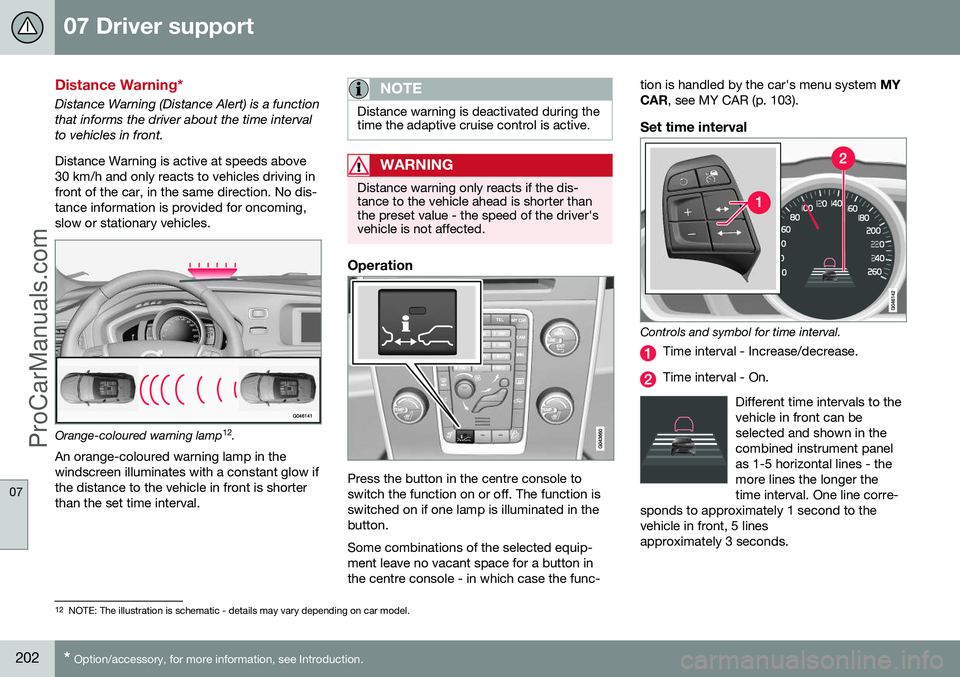
07 Driver support
07
202* Option/accessory, for more information, see Introduction.
Distance Warning*
Distance Warning (Distance Alert) is a function that informs the driver about the time intervalto vehicles in front. Distance Warning is active at speeds above 30 km/h and only reacts to vehicles driving infront of the car, in the same direction. No dis-tance information is provided for oncoming,slow or stationary vehicles.
Orange-coloured warning lamp 12
.
An orange-coloured warning lamp in the
windscreen illuminates with a constant glow if the distance to the vehicle in front is shorterthan the set time interval.
NOTE
Distance warning is deactivated during the time the adaptive cruise control is active.
WARNING
Distance warning only reacts if the dis- tance to the vehicle ahead is shorter thanthe preset value - the speed of the driver'svehicle is not affected.
Operation
Press the button in the centre console to switch the function on or off. The function isswitched on if one lamp is illuminated in thebutton. Some combinations of the selected equip- ment leave no vacant space for a button inthe centre console - in which case the func- tion is handled by the car's menu system
MY
CAR , see MY CAR (p. 103).
Set time interval
Controls and symbol for time interval.
Time interval - Increase/decrease.
Time interval - On.
Different time intervals to the vehicle in front can beselected and shown in thecombined instrument panelas 1-5 horizontal lines - themore lines the longer thetime interval. One line corre-
sponds to approximately 1 second to thevehicle in front, 5 linesapproximately 3 seconds.
12 NOTE: The illustration is schematic - details may vary depending on car model.
ProCarManuals.co’
Page 205 of 442
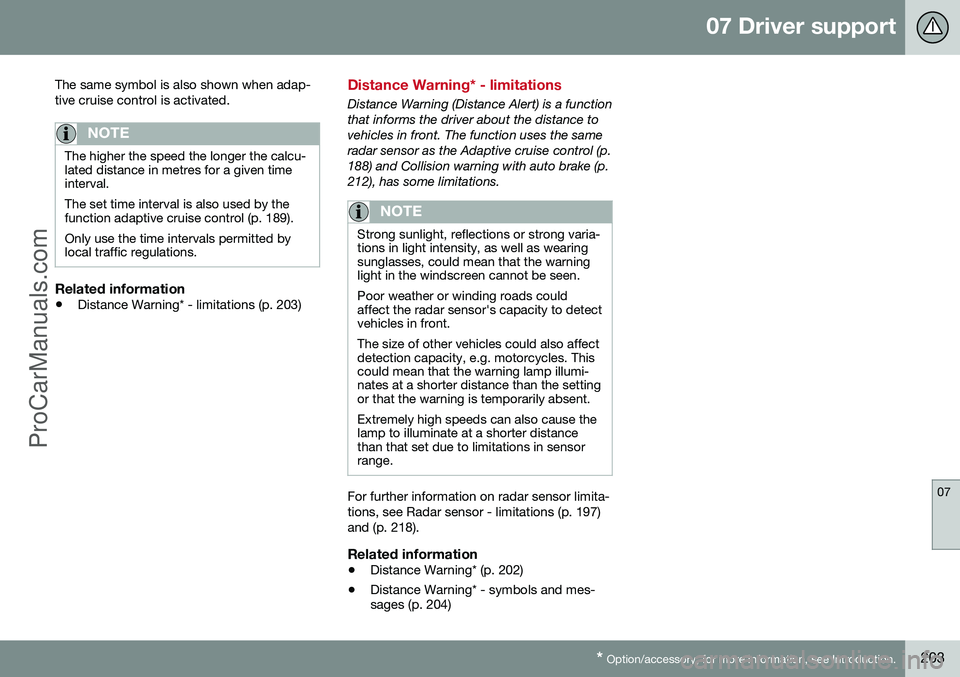
07 Driver support
07
* Option/accessory, for more information, see Introduction.203
The same symbol is also shown when adap- tive cruise control is activated.
NOTE
The higher the speed the longer the calcu- lated distance in metres for a given timeinterval. The set time interval is also used by the function adaptive cruise control (p. 189). Only use the time intervals permitted by local traffic regulations.
Related information
•
Distance Warning* - limitations (p. 203)
Distance Warning* - limitations
Distance Warning (Distance Alert) is a function that informs the driver about the distance tovehicles in front. The function uses the sameradar sensor as the Adaptive cruise control (p.188) and Collision warning with auto brake (p.212), has some limitations.
NOTE
Strong sunlight, reflections or strong varia- tions in light intensity, as well as wearingsunglasses, could mean that the warninglight in the windscreen cannot be seen. Poor weather or winding roads could affect the radar sensor's capacity to detectvehicles in front. The size of other vehicles could also affect detection capacity, e.g. motorcycles. Thiscould mean that the warning lamp illumi-nates at a shorter distance than the settingor that the warning is temporarily absent. Extremely high speeds can also cause the lamp to illuminate at a shorter distancethan that set due to limitations in sensorrange.
For further information on radar sensor limita- tions, see Radar sensor - limitations (p. 197)and (p. 218).
Related information
•Distance Warning* (p. 202)
• Distance Warning* - symbols and mes- sages (p. 204)
ProCarManuals.co’
Page 206 of 442
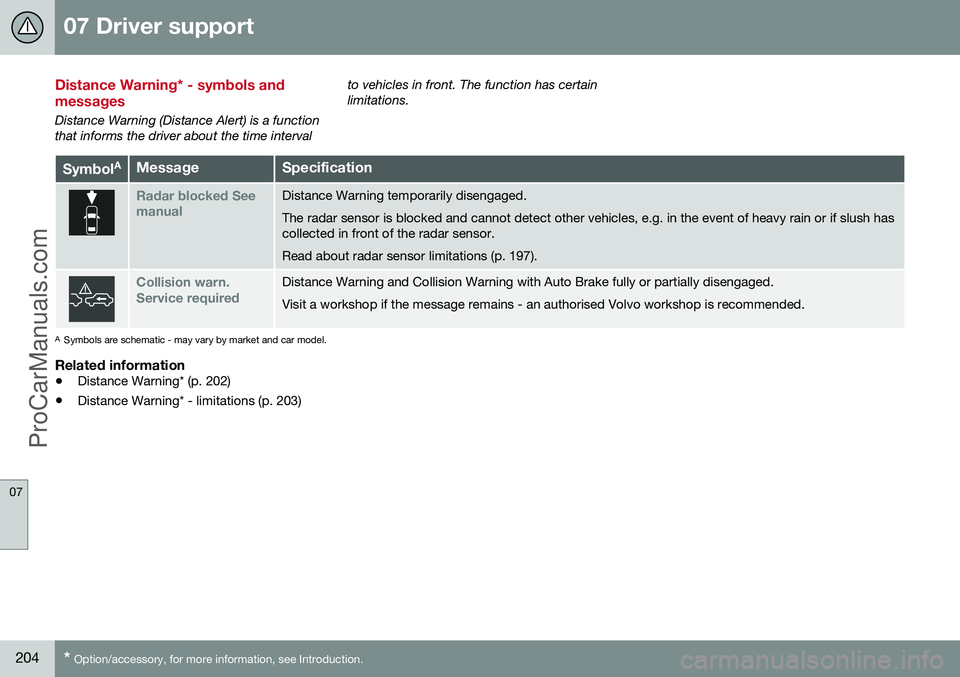
07 Driver support
07
204* Option/accessory, for more information, see Introduction.
Distance Warning* - symbols and messages
Distance Warning (Distance Alert) is a function that informs the driver about the time interval to vehicles in front. The function has certainlimitations.
Symbol
AMessageSpecification
Radar blocked See manualDistance Warning temporarily disengaged. The radar sensor is blocked and cannot detect other vehicles, e.g. in the event of heavy rain or if slush has collected in front of the radar sensor. Read about radar sensor limitations (p. 197).
Collision warn. Service requiredDistance Warning and Collision Warning with Auto Brake fully or partially disengaged. Visit a workshop if the message remains - an authorised Volvo workshop is recommended.
A
Symbols are schematic - may vary by market and car model.
Related information
• Distance Warning* (p. 202)
• Distance Warning* - limitations (p. 203)
ProCarManuals.co’
Page 207 of 442
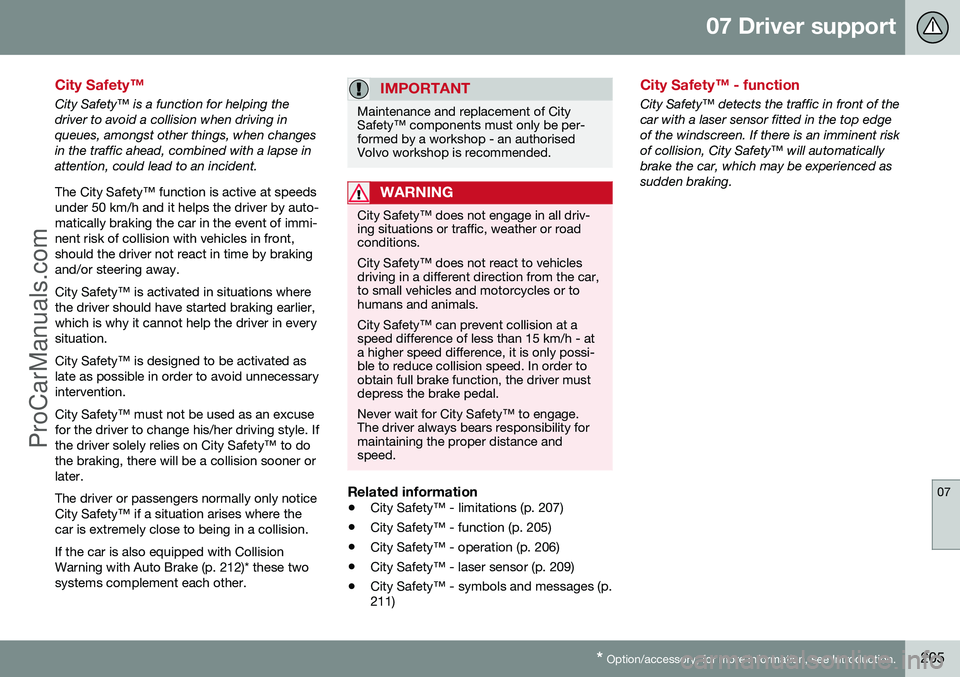
07 Driver support
07
* Option/accessory, for more information, see Introduction.205
City Safety™
City Safety™ is a function for helping the driver to avoid a collision when driving inqueues, amongst other things, when changesin the traffic ahead, combined with a lapse inattention, could lead to an incident. The City Safety™ function is active at speeds under 50 km/h and it helps the driver by auto-matically braking the car in the event of immi-nent risk of collision with vehicles in front,should the driver not react in time by brakingand/or steering away. City Safety™ is activated in situations where the driver should have started braking earlier,which is why it cannot help the driver in everysituation. City Safety™ is designed to be activated as late as possible in order to avoid unnecessaryintervention. City Safety™ must not be used as an excuse for the driver to change his/her driving style. Ifthe driver solely relies on City Safety™ to dothe braking, there will be a collision sooner orlater. The driver or passengers normally only notice City Safety™ if a situation arises where thecar is extremely close to being in a collision. If the car is also equipped with Collision Warning with Auto Brake (p. 212)* these twosystems complement each other.IMPORTANT
Maintenance and replacement of City Safety™ components must only be per-formed by a workshop - an authorisedVolvo workshop is recommended.
WARNING
City Safety™ does not engage in all driv- ing situations or traffic, weather or roadconditions. City Safety™ does not react to vehicles driving in a different direction from the car,to small vehicles and motorcycles or tohumans and animals. City Safety™ can prevent collision at a speed difference of less than 15 km/h - ata higher speed difference, it is only possi-ble to reduce collision speed. In order toobtain full brake function, the driver mustdepress the brake pedal. Never wait for City Safety™ to engage. The driver always bears responsibility formaintaining the proper distance andspeed.
Related information
• City Safety™ - limitations (p. 207)
• City Safety™ - function (p. 205)
• City Safety™ - operation (p. 206)
• City Safety™ - laser sensor (p. 209)
• City Safety™ - symbols and messages (p. 211)
City Safety™ - function
City Safety™ detects the traffic in front of the car with a laser sensor fitted in the top edgeof the windscreen. If there is an imminent riskof collision, City Safety™ will automaticallybrake the car, which may be experienced assudden braking.
ProCarManuals.com
Page 208 of 442
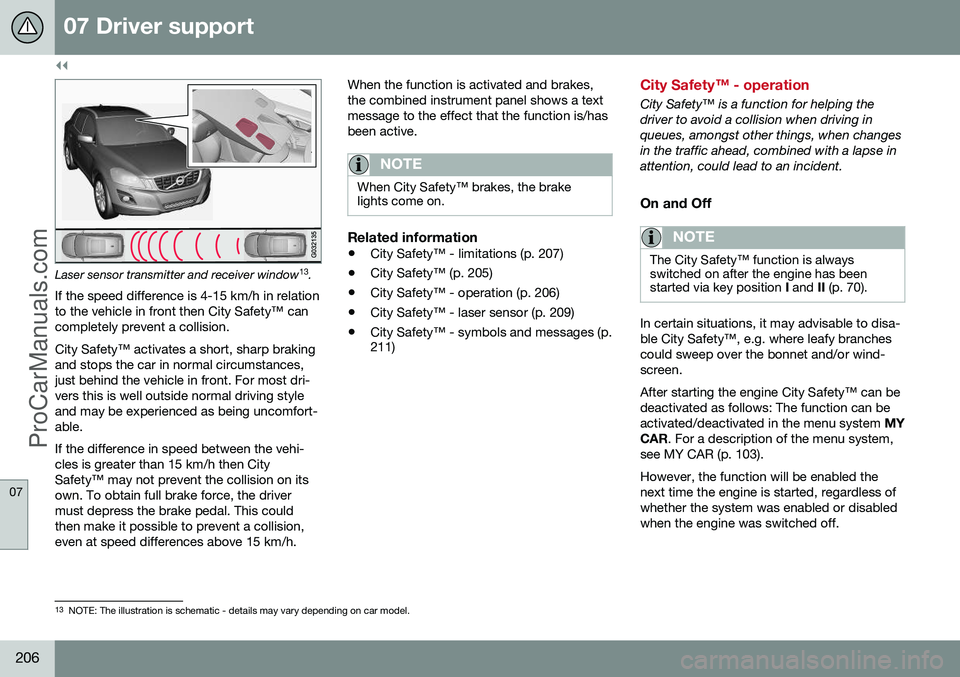
||
07 Driver support
07
206
Laser sensor transmitter and receiver window13
.
If the speed difference is 4-15 km/h in relation to the vehicle in front then City Safety™ cancompletely prevent a collision. City Safety™ activates a short, sharp braking and stops the car in normal circumstances,just behind the vehicle in front. For most dri-vers this is well outside normal driving styleand may be experienced as being uncomfort-able. If the difference in speed between the vehi- cles is greater than 15 km/h then CitySafety™ may not prevent the collision on itsown. To obtain full brake force, the drivermust depress the brake pedal. This couldthen make it possible to prevent a collision,even at speed differences above 15 km/h. When the function is activated and brakes,the combined instrument panel shows a textmessage to the effect that the function is/hasbeen active.
NOTE
When City Safety™ brakes, the brake lights come on.
Related information
•
City Safety™ - limitations (p. 207)
• City Safety™ (p. 205)
• City Safety™ - operation (p. 206)
• City Safety™ - laser sensor (p. 209)
• City Safety™ - symbols and messages (p. 211)
City Safety™ - operation
City Safety™ is a function for helping the driver to avoid a collision when driving inqueues, amongst other things, when changesin the traffic ahead, combined with a lapse inattention, could lead to an incident.
On and Off
NOTE
The City Safety™ function is always switched on after the engine has beenstarted via key position
I and II (p. 70).
In certain situations, it may advisable to disa- ble City Safety™, e.g. where leafy branchescould sweep over the bonnet and/or wind-screen. After starting the engine City Safety™ can be deactivated as follows: The function can beactivated/deactivated in the menu system MY
CAR . For a description of the menu system,
see MY CAR (p. 103). However, the function will be enabled the next time the engine is started, regardless ofwhether the system was enabled or disabledwhen the engine was switched off.
13 NOTE: The illustration is schematic - details may vary depending on car model.
ProCarManuals.co’
Page 209 of 442
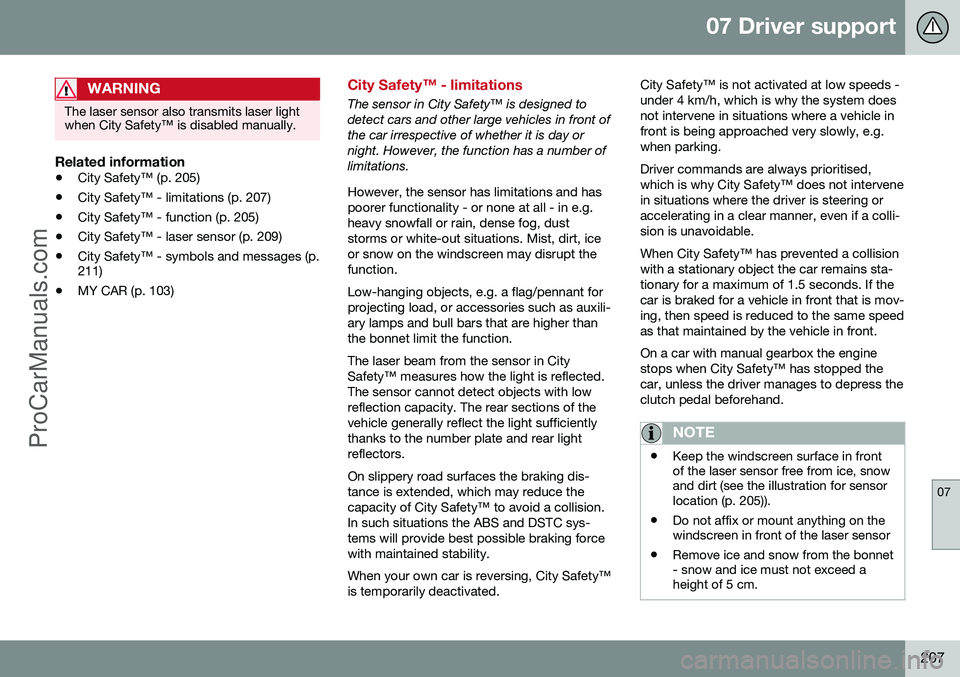
07 Driver support
07
207
WARNING
The laser sensor also transmits laser light when City Safety™ is disabled manually.
Related information
•City Safety™ (p. 205)
• City Safety™ - limitations (p. 207)
• City Safety™ - function (p. 205)
• City Safety™ - laser sensor (p. 209)
• City Safety™ - symbols and messages (p. 211)
• MY CAR (p. 103)
City Safety™ - limitations
The sensor in City Safety™ is designed to detect cars and other large vehicles in front ofthe car irrespective of whether it is day ornight. However, the function has a number oflimitations. However, the sensor has limitations and has poorer functionality - or none at all - in e.g.heavy snowfall or rain, dense fog, duststorms or white-out situations. Mist, dirt, iceor snow on the windscreen may disrupt thefunction. Low-hanging objects, e.g. a flag/pennant for projecting load, or accessories such as auxili-ary lamps and bull bars that are higher thanthe bonnet limit the function. The laser beam from the sensor in City Safety™ measures how the light is reflected.The sensor cannot detect objects with lowreflection capacity. The rear sections of thevehicle generally reflect the light sufficientlythanks to the number plate and rear lightreflectors. On slippery road surfaces the braking dis- tance is extended, which may reduce thecapacity of City Safety™ to avoid a collision.In such situations the ABS and DSTC sys-tems will provide best possible braking forcewith maintained stability. When your own car is reversing, City Safety™ is temporarily deactivated. City Safety™ is not activated at low speeds -under 4 km/h, which is why the system doesnot intervene in situations where a vehicle infront is being approached very slowly, e.g.when parking. Driver commands are always prioritised, which is why City Safety™ does not intervenein situations where the driver is steering oraccelerating in a clear manner, even if a colli-sion is unavoidable. When City Safety™ has prevented a collision with a stationary object the car remains sta-tionary for a maximum of 1.5 seconds. If thecar is braked for a vehicle in front that is mov-ing, then speed is reduced to the same speedas that maintained by the vehicle in front. On a car with manual gearbox the engine stops when City Safety™ has stopped thecar, unless the driver manages to depress theclutch pedal beforehand.
NOTE
•
Keep the windscreen surface in front of the laser sensor free from ice, snowand dirt (see the illustration for sensorlocation (p. 205)).
• Do not affix or mount anything on thewindscreen in front of the laser sensor
• Remove ice and snow from the bonnet- snow and ice must not exceed aheight of 5 cm.
ProCarManuals.co’
Page 210 of 442
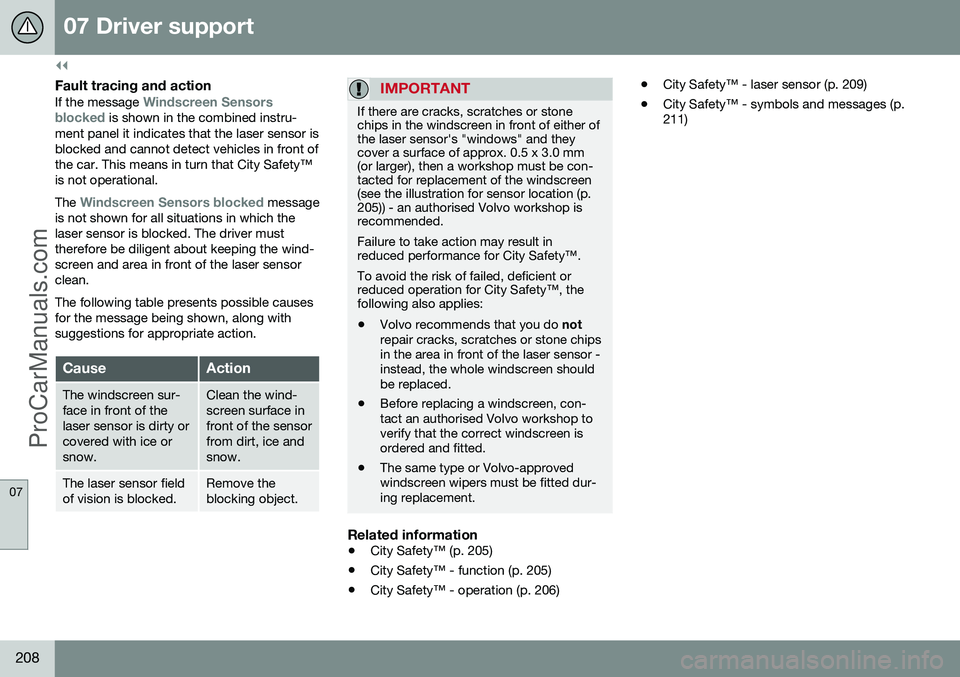
||
07 Driver support
07
208
Fault tracing and action
If the message Windscreen Sensors
blocked is shown in the combined instru-
ment panel it indicates that the laser sensor is blocked and cannot detect vehicles in front ofthe car. This means in turn that City Safety™is not operational. The
Windscreen Sensors blocked message
is not shown for all situations in which the laser sensor is blocked. The driver musttherefore be diligent about keeping the wind-screen and area in front of the laser sensorclean. The following table presents possible causes for the message being shown, along withsuggestions for appropriate action.
CauseAction
The windscreen sur- face in front of thelaser sensor is dirty orcovered with ice orsnow.Clean the wind- screen surface infront of the sensorfrom dirt, ice andsnow.
The laser sensor field of vision is blocked.Remove the blocking object.
IMPORTANT
If there are cracks, scratches or stone chips in the windscreen in front of either ofthe laser sensor's "windows" and theycover a surface of approx. 0.5 x 3.0 mm(or larger), then a workshop must be con-tacted for replacement of the windscreen(see the illustration for sensor location (p.205)) - an authorised Volvo workshop isrecommended. Failure to take action may result in reduced performance for City Safety™. To avoid the risk of failed, deficient or reduced operation for City Safety™, thefollowing also applies:
• Volvo recommends that you do
not
repair cracks, scratches or stone chips in the area in front of the laser sensor -instead, the whole windscreen shouldbe replaced.
• Before replacing a windscreen, con-tact an authorised Volvo workshop toverify that the correct windscreen isordered and fitted.
• The same type or Volvo-approvedwindscreen wipers must be fitted dur-ing replacement.
Related information
•
City Safety™ (p. 205)
• City Safety™ - function (p. 205)
• City Safety™ - operation (p. 206) •
City Safety™ - laser sensor (p. 209)
• City Safety™ - symbols and messages (p. 211)
ProCarManuals.co’